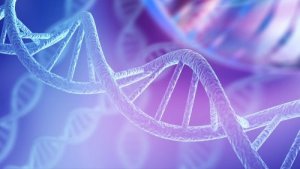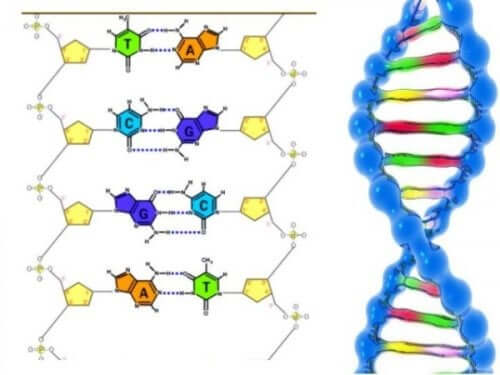How to Explain DNA to Children

Today we’d like to present a simple recipe to help you explain DNA to children and introduce them to the fascinating world of science. And who knows? One day your little ones may become great scientists.
Can such a tiny particle like DNA really be responsible for controlling activity throughout our entire bodies? Yes, it can. And it’s present in every single living organism. It’s what makes us look like our parents, in good ways and bad.
James Watson, the father of DNA (1953) once said that: “We used to think that our fate was in our stars. Now we are told that it is in our genes.”
Before going any further, we should first answer the big question: What is DNA?
What is DNA?
Deoxyribonucleic acid (DNA) is a double-strained molecule that is formed by nitrogen bases and phosphate pentoses. It’s the nucleic acid that contains the genetic and hereditary information of living things.
What’s more, it’s responsible for the functioning not only of cells themselves but the entire organism. This information is contained in smaller nucleotide sequences called genes. These genes will be read and translated into proteins, which are responsible for carrying the orders contains within the DNA.

The recipe for explaining DNA to children
To explain DNA to children with today’s recipe, you first need the right container. The nucleus of a eukaryotic cell would be ideal. If you can’t find one, then a prokaryotic cell may also work – such as a bacteria. Prokaryotic cells have DNA spread out in their cytoplasm and lack a nucleus, but that doesn’t matter.
It’s very important to carry out this process at a temperature of 86 to 95 degrees. This temperature range favors the formation of the links between the different components of DNA.
Ingredients:
- Purine nitrogenous bases. These are chemical compounds formed by two rings that are joined together. They contain carbon, hydrogen, and nitrogen. We should grab those with the letter A for adenine and the letter G for guanine.
- Pyramidinic nitrogenous bases. These chemical compounds are formed by a single hexagonal ring of carbon, hydrogen, and nitrogen. It’s important to be careful when the time comes to choose them. Only those that contain the letter T for thymidine and C for cytosine will do. If you choose those with the letter U for uracil, then you’ll end up with ARN instead of DNA.
- Pentoses. A little bit of sugar to sweeten up our recipe. Take note: The sugar that makes up part of the DNA structure is deoxyribose. Ribose sugar, on the other hand, is what’s used in the fabrication of ARN.
- Phosphates. In order to complete our DNA molecule, we must add a phosphate group to each one of the sugars. That way, we’ll obtain a phosphate pentose. The phosphate is present both in DNA molecules as well as ARN molecules, so here there’s no danger of making a mistake.
Let’s test the results of our recipe to explain DNA to children
We should wait a while to allow for the formation of the corresponding bonds between different molecules. Once the time is up, our DNA molecule will have taken on the shape of railroad track – if we were to stretch it out. However, in its natural state, we’ll observe something similar to a spiral staircase.
Interesting facts about DNA
The resulting order of the letters (nitrogenous bases) of our DNA is important, as they communicate a message. Each segment of our DNA determines a gene, and each gene refers to a characteristic that we possess. For example, the color of our hair, or that of our eyes, etc.

We have between 25,000 and 35,000 genes in each cell in our bodies. A very long gene may contain up to 10,000 pairs of nitrogenous bases, and each cell can host up to 3,200 million nucleotide bases.
The nucleus of a eukaryotic cell measures some 5 microns and an extended DNA molecule measures some 6.5 feet. How does all of this information fit into something so small?
All of the information contained in the genes folds up until it forms structures called chromosomes, with a size of 20 microns. Human beings store all of this genetic information in 23 chromosome pairs. The Human Genome Project, which began in the 1990s, finally concluded the complete sequencing of human DNA in 2016.
A final tip to explain DNA to children
To explain DNA to children, any resource or interesting data that reinforces your explanation will awaken their curiosity to learn more. Making your own model of a DNA molecule with candies and liquorice strips is a great way to get started.
Today we’d like to present a simple recipe to help you explain DNA to children and introduce them to the fascinating world of science. And who knows? One day your little ones may become great scientists.
Can such a tiny particle like DNA really be responsible for controlling activity throughout our entire bodies? Yes, it can. And it’s present in every single living organism. It’s what makes us look like our parents, in good ways and bad.
James Watson, the father of DNA (1953) once said that: “We used to think that our fate was in our stars. Now we are told that it is in our genes.”
Before going any further, we should first answer the big question: What is DNA?
What is DNA?
Deoxyribonucleic acid (DNA) is a double-strained molecule that is formed by nitrogen bases and phosphate pentoses. It’s the nucleic acid that contains the genetic and hereditary information of living things.
What’s more, it’s responsible for the functioning not only of cells themselves but the entire organism. This information is contained in smaller nucleotide sequences called genes. These genes will be read and translated into proteins, which are responsible for carrying the orders contains within the DNA.

The recipe for explaining DNA to children
To explain DNA to children with today’s recipe, you first need the right container. The nucleus of a eukaryotic cell would be ideal. If you can’t find one, then a prokaryotic cell may also work – such as a bacteria. Prokaryotic cells have DNA spread out in their cytoplasm and lack a nucleus, but that doesn’t matter.
It’s very important to carry out this process at a temperature of 86 to 95 degrees. This temperature range favors the formation of the links between the different components of DNA.
Ingredients:
- Purine nitrogenous bases. These are chemical compounds formed by two rings that are joined together. They contain carbon, hydrogen, and nitrogen. We should grab those with the letter A for adenine and the letter G for guanine.
- Pyramidinic nitrogenous bases. These chemical compounds are formed by a single hexagonal ring of carbon, hydrogen, and nitrogen. It’s important to be careful when the time comes to choose them. Only those that contain the letter T for thymidine and C for cytosine will do. If you choose those with the letter U for uracil, then you’ll end up with ARN instead of DNA.
- Pentoses. A little bit of sugar to sweeten up our recipe. Take note: The sugar that makes up part of the DNA structure is deoxyribose. Ribose sugar, on the other hand, is what’s used in the fabrication of ARN.
- Phosphates. In order to complete our DNA molecule, we must add a phosphate group to each one of the sugars. That way, we’ll obtain a phosphate pentose. The phosphate is present both in DNA molecules as well as ARN molecules, so here there’s no danger of making a mistake.
Let’s test the results of our recipe to explain DNA to children
We should wait a while to allow for the formation of the corresponding bonds between different molecules. Once the time is up, our DNA molecule will have taken on the shape of railroad track – if we were to stretch it out. However, in its natural state, we’ll observe something similar to a spiral staircase.
Interesting facts about DNA
The resulting order of the letters (nitrogenous bases) of our DNA is important, as they communicate a message. Each segment of our DNA determines a gene, and each gene refers to a characteristic that we possess. For example, the color of our hair, or that of our eyes, etc.

We have between 25,000 and 35,000 genes in each cell in our bodies. A very long gene may contain up to 10,000 pairs of nitrogenous bases, and each cell can host up to 3,200 million nucleotide bases.
The nucleus of a eukaryotic cell measures some 5 microns and an extended DNA molecule measures some 6.5 feet. How does all of this information fit into something so small?
All of the information contained in the genes folds up until it forms structures called chromosomes, with a size of 20 microns. Human beings store all of this genetic information in 23 chromosome pairs. The Human Genome Project, which began in the 1990s, finally concluded the complete sequencing of human DNA in 2016.
A final tip to explain DNA to children
To explain DNA to children, any resource or interesting data that reinforces your explanation will awaken their curiosity to learn more. Making your own model of a DNA molecule with candies and liquorice strips is a great way to get started.
This text is provided for informational purposes only and does not replace consultation with a professional. If in doubt, consult your specialist.








